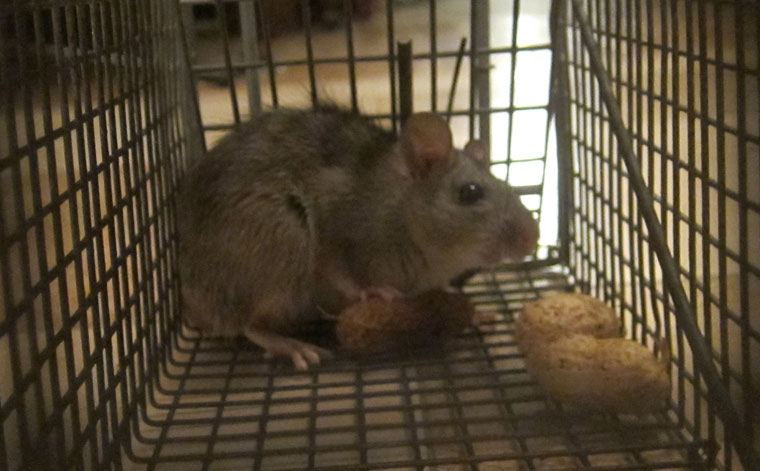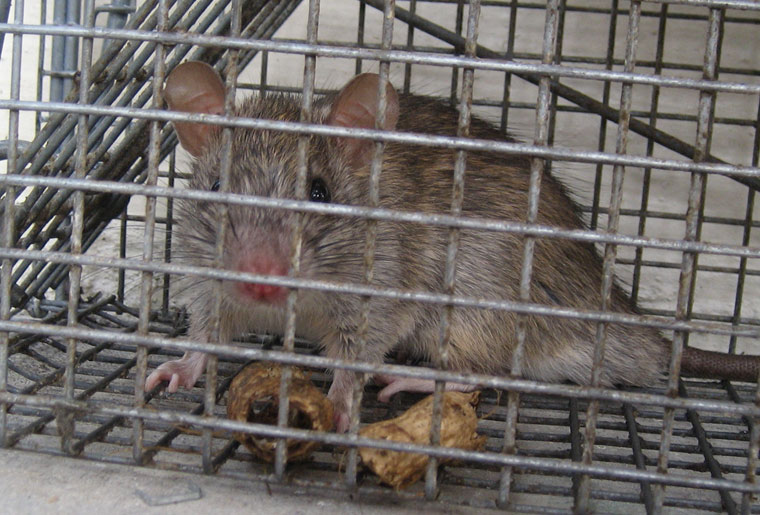- info@wildlife-removal.com
Call us for help in your town
Wildlife Removal Education
Can Live Trapping Rats Work to Get Rid of Them?
Need rat removal in your hometown? We service over 500 USA locations! Click here to hire us in your town and check prices - updated for year 2020.
In a perfect world, it would be easy to get rid of pest animals by simply trapping them all up and releasing them far away. This is a process that CAN work for some pest animals too, including rats, but only in that perfect dream scenario. Sadly, the scenario we hope for very rarely exists, and rat infestations are larger, costlier, and much more destructive than we first anticipated.

Seeing one rat in a building never means that there is just one solo rat; it means that there is an entire group of them, because they are very social animals. You won't ever find just the one rat living on its own. There will be others - adults and babies alike, and they'll all be running riot around your home, chewing wires, spreading disease, and doing the annoying things that rats do. Live cage traps usually only deal with one or a few rats at a time. You can get larger traps that are designed to catch four or five mice or rats, but these are obviously going to be more expensive than using snap traps, designed to kill one rat at a time.
Live trapping of rats only works when you seal up the building after making sure that EVERY rat has been removed from within it, and then releasing those rats into the wild somewhere far enough away from your home that they can't come right back again. In most cases, this is around the five-miles mark, but the more you can drive, the better the outcome. They use pheromones in urine to communicate with each other, but they also have a number of other communicative tools as their disposal. They are VERY good at making their way back home after getting lost in the wild.
Other suggestions that have been made by experts in the field of trapping and releasing of rats also recommend putting something like a river or large lake between the property that you trapped the rats in, and the new spot that you plan to release them. This doesn't always work as rats can swim very well, but looking for something like a forest of heavily treed area can also have a keep-away effect. The woods and trees have plenty of predators that will naturally ensure they don't get too close to your habitat again.
If you would like our expert opinion, we do not recommend trapping rats and then releasing them back into the wild, mostly because their numbers are already out of control in many states. In areas where rat infestations are plentiful, it would be foolish to release the animal again, giving it another chance to start another infestation somewhere else. Although we hope for a happy life for the animals that we evict from our homes, it's not always possible. Rats is just one of the animals that it isn't always possible for.
Where to Release Captured Rats?
You shouldn't attempt to capture rats if you have an infestation of them in your home, because it doesn't usually end up being the most cost or time-effective solution. When you have a colony that might be a few hundred rats strong, getting rid of them one or two at a time with catch-and-release methods is not only going to be a long and arduous task, but also one that results in you notching up a lot of miles.

Rats can travel some distance, especially when they are trying to find their way back home, and you will need to drive for some distance before you can think about releasing them.
Before you take the trap and release approach to rat removal, there are a few truths you should know:
1 - Rats that are removed from their group and then deposited into a brand new territory, miles away, are probably going to die within a few weeks. They will need to fight an existing hierarchy of rats in that new territory. If they are urban rats, they may not have seen any of the predators that they will now come up against in the wild. Again, if they are urban rats, they'll have a hard time trying to find the best nesting spots, food, and sources of water. It won't take long before a trapped and released rat dies, either of exposure, dehydration, starvation, or predatory attack.
2 - Rats that are removed from their group and then deposited into a brand new territory, miles away, are probably going to find their own way back to your house before you even make it there. You would need to drive a minimum of five miles, preferably more than that, before you could release a rat. Some experts even advise that you put a body of water between the rat and your property too, but rats can swim excellently are quite unlikely to be deterred.
3 - Rats are incredibly social animals. There won't even be just one rat in your home - it will be part of a much bigger group. Using trap and release methods CAN work (in rare cases), but you must make sure that you go through the motions of sealing the building too. Otherwise, the rats that you release can come right back, and even if they don't, the pheromones left behind by the rest of the group will soon have others come flocking, along with some predators of rats too.
If you still want to trap and release rats, the release point should be:
- At least five miles away from your home.
- Preferably with a body of water in between your home and the release point, such as a river.
- Away from commercial or residential areas, otherwise you'll be creating a problem for someone else.
- Close to a source of water.
- In forested areas or woods - plenty of undergrowth and tree hollows to try and hide in.
- Released in the morning - rats are nocturnal animals but can be awake during the day. The majority of rat predators are awake at night, so releasing in the morning gives them the best chance of survival.
Go back to the Rat Removal page, or learn tips to do it yourself with my How to Get Rid of Rats guide.


















